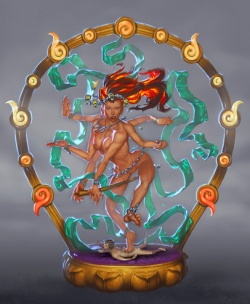Dakini – In Tibetan Buddhism
Although dakini figures appear in Hinduism and in the Bön tradition, dakinis are particularly prevalent in Vajrayana Buddhism and have been particularly conceived in Tibetan Buddhism where the dakini, generally of volatile or wrathful temperament, act somewhat as a muse (or.Although dakini figures appear in Hinduism and in the Bön tradition, dakinis are particularly prevalent in Vajrayana Buddhism and have been particularly conceived in Tibetan Buddhism where the dakini, generally of volatile or wrathful temperament, act somewhat as a muse (or inspirational thoughtform) for spiritual practice. Dakinis are energetic beings in female form, evocative of the movement of energy in space. In this context, the sky or space indicates shunyata, the insubstantiality of all phenomena, which is, at the same time, the pure potentiality for all possible manifestations.
Dakinis, being associated with energy in all its functions, are linked with the revelation of the Anuttara Yoga Tantras or Higher Tantras, which represent the path of transformation. Here, the energy of negative emotions or kleshas, called poisons, are transformed into the luminous energy of enlightened awareness or gnosis (jnana) yielding rigpa. When considered as a stage on the Vajrayana Path, the dakini is the last of the stages: the first is the guru, which corresponds to the initial realization of the true condition of reality, as this is introduced by the guru in the empowerment, if the disciple obtains what the Inner Tantras call peyi yeshe (dpe yi ye shes); the second is the devata, which corresponds to the Contemplation insofar as the devata is the method we use for developing the state discovered in the initial realization of the true condition of reality; the third and last is the dakini insofar as the dakini is the source of the activities of realization. In Dzogchen (rdzogs chen) these three correspond to tawa (lta ba), gompa (sgom pa) and chöpa (spyod pa): the first is the direct Vision of the true nature of reality rather than an intellectual view of reality, as is the case with the term in other vehicles; the second is the continuity of this Vision in sessions of Contemplation; and the third is the continuity of this Vision in the everyday activities, and the use of imperfection for making the Vision uninterrupted. Qua base, the dakinis are the energies of life; qua Path, they are the activities of advanced practitioners; qua Fruit, they are the actionless activities of realized Masters. According to tradition, a Dakini gave a black hat to the third Karmapa, Rangjung Dorje (1284 - 1339), when he was three years old., The Black Crown became the emblem of the oldest reincarnating Tibetan lineage. Classes of Dakini Judith Simmer-Brown, based on teachings she received from Tibetan lamas, identifies four main classes of dakini. These follow the Twilight Language tradition of esotericism in referring to secret, inner, outer and outer-outer classes of dakinis. The secret class of dakini is Prajnaparamita (Tibetan yum chenmo) or voidness, the empty nature of reality according to Mahayana doctrine. The inner class of dakini is the dakini of the mandala, a meditational deity (Tibetan:yidam) and fully enlightened Buddha who helps the practitioner recognise their own Buddhahood. The outer dakini is the physical form of the dakini, attained through Completion Stage Tantra practices such as the Six Yogas of Naropa that work with the subtle winds of the subtle body so that the practitioner's body is compatible with an enlightened mind. The outer-outer dakini is a dakini in human form. She is a yogini, or Tantric practitioner in her own right but may also be a karmamudra, or consort, of a yogi or mahasiddha. Dakinis can also be classified according to the Trikaya, or three bodies of a Buddha. The dharmakaya dakini, which is Samantabhadri, represents the dharmadhatu where all phenomena appear. The sambhogakaya dakinis are the yidams used as meditational deities for tantric practice. The nirmanakaya dakinis are human women born with special potentialities, these are realized yogini, the consorts of the gurus, or even all women in general as they may be classified into the five Buddha-families.
